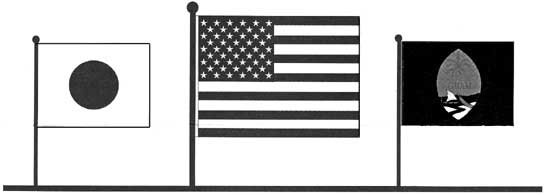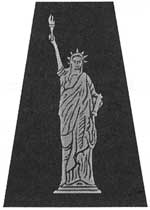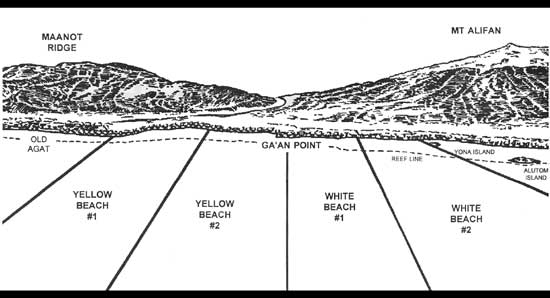|
WAR IN THE PACIFIC National Historical Park |
U.S. Department of the Interior National Park Service |

|
Ga'an Point

Shortly after the attack on Pearl Harbor in 1941 during the second World War, Japanese troops invaded Guam and occupied the island for 32 months. A U.S. territory since 1898, Guam was one of the few U.S. territories to be occupied during the war. As the focus of the war shifted to the Pacific, the recapture of Guam became a critical part of the Marianas Campaign, aimed at establishing a beachhead in the western Pacific. The landing of 55,000 U.S. troops began early on the morning of July 21, 1944 (W-day) after days of heavy air and naval bombardment. The first landings took place on the beaches at Asan and Agat.
THE LANDING AT AGAT BEACH

The landing beach at Agat stretched from the old village of Agat to Bangi Point. Behind lay the highlands of Mt. Alifan and Maanot Ridge. Ga'an Point was the geographic center of the Agat Beachhead and served as a strategic firing base for Japanese coastal defense weapons in the area. Once Ga'an Point was taken, the entire beachfront at Agat could be used to offload supplies and equipment which were critical for the inland advance.
Naval and air bombardment of the beaches at Asan and Agat continued for days prior to the assault on July 21. Both beaches were heavily fortified by the Japanese. At Agat, offshore fortifications included palm log cribs filled with coral and joined together by wire cable.
Over 1,000 such obstacles were blasted away in the offshore waters by members of the Underwater Demolition Teams (UDTs) in the 3 days prior to the landings. These advance preparations were essential to the successful landings that followed.
Initial landings at Agat were made by members of the 1st Provisional Marine Brigade (which included the 4th Marine Division and the 22nd Marine Division), followed by the U.S. Army's 77th Infantry Division, 305th Regimental Combat Team. Plans were to establish a southern beachhead, secure old Agat Village, link up with the troops landing at Asan, and drive north to the Orote Peninsula, one of the prime targets of the invasion force.
THE JAPANESE RESISTANCE
Japanese resistance at Agat was particularly stiff, and casualties were high that first day: well over a thousand men were wounded, killed or missing in action at Agat alone. As LVTs (Landing Vehicle Tracked) approached the beach across the wide reef at Agat, mortar and artillery fire fell upon them. As the 22nd U.S. Marines approached the shore, the two 75 mm guns, a 37 mm gun, and machine guns emplaced at Ga'an Point inflicted considerable damage on both the landing craft and the marines fighting their way ashore. A frontal assault failed to knock out these defenses; the emplacements at Ga'an Point were eventually knocked out by tanks in an assault from the rear later in the day.
The first night on the beach was a long one, as troops waited for the Japanese to counterattack, and ammunition ran low. The evacuation of casualties was particularly difficult on the exposed beaches. One aid station party received a direct hit from a 75mm gun as it landed; medical supplies were destroyed, and only one member of the medical team escaped unharmed. The 22nd battalion survived without a doctor until well into the afternoon. It was three days before the southern beachhead was firmly established on July 24.

THE GUNS AT GA'AN POINT
The island was declared secure on August 10, by which time most of the fortifications had been destroyed. The Japanese fortifications at Ga'an are among the most impressive remaining on the southern beaches. Similar Japanese coastal defense fortifications are visible nearby at Apaca Point and Rizal Point, just to the north of Ga'an Point.
The defense weapons emplaced at Ga'an Point included a single-barrel, Japanese dual-purpose 25 mm machine cannon and a 20 cm short barrel naval gun, similar to the one preserved at Ga'an Point today. The 25 mm machine cannon at Ga'an today is a double-barrelled anti-aircraft gun.
Also preserved at Ga'an are the remains of a large Japanese blockhouse, built during the final months before the July 21 assault and largely concealed beneath a small hill. The stronghold at Ga'an Point played an important role in Japanese defense of the area and was one of the last fortifications to fall. Note the Japanese inscription on the concrete wall of the blockhouse visible on the top of the hill.
GA'AN POINT TODAY
Agat was a major rice growing area in the pre-war years. The population of Agat at the time of the war was about 800. The modern village of Agat lies south of the original village; nothing remains today of old Agat.
The flags of the United States, Japan and Guam fly at Ga'an Point in memory of all who died during the conflict here. There were over 7000 American casualties in the battle for Guam; the exact number of Guamanian casualties is unknown. Japanese forces on Guam numbered close to 18,500; just over 1,000 of these were taken prisoner. The rest were killed in action, died of wounds, or committed suicide.
The landing beaches at Agat, including Ga'an Point, are now part of War in the Pacific National Historical Park, established by U.S. Congress in 1978 "to commemorate the bravery and sacrifice of those participating in the campaigns of the Pacific theater of World War II, and to conserve and interpret outstanding natural, scenic and historic values and objects on the island of Guam for the benefit and enjoyment of present and future generations." Ga'an Point is one of seven units included in the park. The landing beaches at Asan are preserved as well, in the Asan Beach unit.
Last Updated: 01-Apr-2004